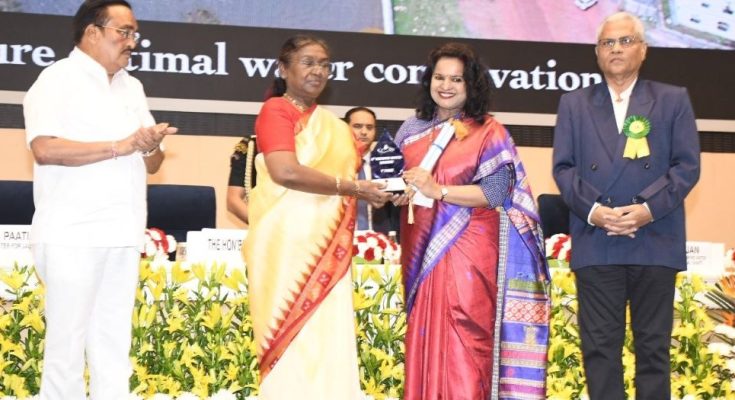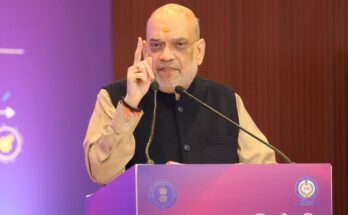National Water Award: The State of Odisha has been conferred 5th National Water Award as the First Rank in the Best State Category honoured by the Ministry of Jal Shakti, Govt. of India for the work done in the field of Water Resources Conservation and Management.
On behalf of the State, Development Commissioner-cum-Additional Chief Secretary to Government, Odisha Smt. Anu Garg, IAS has received this Award today from President of India Smt. Draupadi Murmu in a programme held at Vigyan Bhawan, New Delhi.
This success has been achieved due to the various activities of performances by DoWR during the year. 369 million cum of water storage facilities have been developed by completing Lower Suktel Dam and Haldia dam for meeting irrigation, drinking water requirements etc. For conservation of water resources, 28 Instream Storage Structures (ISS) are in progress & 18 ISS are in tendering stage to store nearly 50 million cum of water; 317 Check Dams completed under state funded scheme MATY to store nearly 2.0 million cum of water and to provide irrigation to 7120 hectares.
Further, 144 MIPs have been renovated and 3.0 million cum water storage capacity enhanced. Under Amrit Sarobar Yojana, renovation of 2385 tanks have been completed out of 4,656 nos. identified tanks and work in 886 tanks is in progress. 22,777 RWHS have been constructed under MUKTA scheme during the year.
Due to adoption of underground pipeline in the distribution systems in all categories of irrigation projects, the irrigation efficiency of the projects by and large has been increased by more than 20%. To increase water use efficiency SCADA based water management system and crop diversification has been adopted.
More than 2.21 lakh ha area provided with irrigation facilities benefitting more than 2.5 lakh farmers along with stabilization of 0.45 lakh ha of irrigation area, which includes distribution system of Subarnarekha major irrigation project (10,000 ha.), Gangadhar Meher Lift Canal (25,600 ha.), Baitarani Left Bank Canal of Integrated Anandapur Barrage Project (1400 ha.) and Extension of Harbhangi medium project (2400 ha.). Moreover, 59 Mega lift irrigation projects for 81,216 hectares of upland area and 15,403 Deep Bore Wells & 2,890 Community LIPs have been installed with creation of 1,39,317 hectares of irrigation command. Further, 90,927 ha of irrigated area transformed from conventional to micro irrigation benefiting 86,847 farmers.
06 new major and medium irrigation projects namely Brutang Dam, Nabarangpur Lift Irrigation, Kharibhandan barrage, Pipalapanka dam, Samakoi barrage & Upper lanth dam and 33 megalift irrigation projects have been taken up to provide irrigation to 1.17 lakh hectares.
Raising & strengthening of nearly 200 Km of saline embankments have been taken up under Mukshyamantri Cyclone Resilient Saline Embankments Project to prevent storm surge effect during cyclones and to arrest saline ingress during high tides in the coastal areas.
Pani Panchayat Act has been amended to include spouses of the water users. Further, large scale micro water conservation activities under Jal Shakti Abhiyan have been taken up throughout the state. District Scientific Water Conservation plan has been prepared for 22 districts and Jal Shakti Kendra has been set up in all the thirty districts.
Odisha is the 1st State to enact Faecal Sludge & Septage Management Regulations, 2018 for all the 114 ULBs where, Faecal Sludge & Septage Treatment Plants (FSTPs) have been provided for treatment of faecal sludge from onsite sanitation system. Mission Shakti Groups and Transgender Groups have been trained and engaged for O&M of FSTPs in 87 ULBs. Odisha has moved from having a single operational FSTP in 2016 with 2% of urban faecal treated to operationalizing 113 FSTP achieving 98% accesses to safe sanitation for urban population.
Sewerage Treatment Plants have been implemented in Bhubaneswar, Cuttack, Puri, Sambalpur and Rourkela and wastewater Treatment plant has been constructed at Talcher Town. Industrial waste water treatment is being regulated under the consent administration of Board. Out of 1368 water polluting industries in the state, 1327 industries have installed captive Effluent Treatment Plants (ETP) to treat 818 MLD of industrial waste water.
As per the report of CPCB, Odisha’s polluted river stretches have decreased from 19 to 7 by improving the water quality.
DC-cm-ACS, Department of Water Resources Department, Odisha Smt. Garg on receiving this prestigious award has expressed her pleasure and said that this success has been achieved due to the joint effort of Government, DoWR officers, engineers working at the state and field level and all those associated with execution of different schemes and programmes of DoWR , including SHGs and PPs.




